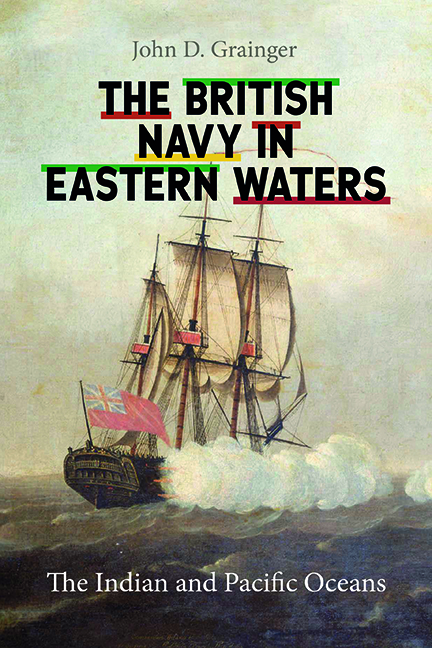Summary
The subject of this book is the activities of the British Royal Navy in the Indian and the western Pacific Oceans, that is, in over half the world, from the Cape of Good Hope to China and Japan. Neither of these oceans and the lands they gave access to were known to European before the ‘Age of Discoveries’, though they were well enough known to many inhabitants of these regions, and certainly rumours and hints had reached Europeans of their existence. It was, of course, difficult for any European ships to penetrate into these oceans even in the century or so after the initial Portuguese explorations had reached them. This was in contrast to the accessibility of the contemporary revelation of the American continents, which seemed to be, by comparison, relatively easy to reach. It was clearly possible for English, French, and Dutch ships to get across the Atlantic and to interrupt Spanish activities in the Caribbean, and perhaps in West Africa and Brazil, but to reach the Pacific Ocean or the Indian Ocean required a voyage of years, far more courage and endurance, and a greater financial investment, than was involved in sailing to the east coast of America.
It was not at first known whether this could be done at all. Vasco da Gama, following Bartholomew Diaz and a long list of earlier Portuguese sailors, reached the Indian Ocean in 1498. The Portuguese had been moving slowly down the coast of Africa for a century before then, and had established a precarious control over the coast and its trade from Morocco southwards. They had even established a presence on the coast of eastern South America – Brazil – discovered in about 1500, and were gaining some control there. They did not wish any other Europeans to interfere with the profits they had been making in the Indian and Spice Island trades, any more than the Spaniards wanted others to interfere in the Caribbean. The two states had a treaty to that effect, ratified by the Pope, though no other country recognised it. Nonetheless this was the foundation of their empires. When other Europeans’ ships actually reached the Indian Ocean, they found that the main ports were already under Portuguese control – though there were always other ports which they could use.
- Type
- Chapter
- Information
- The British Navy in Eastern WatersThe Indian and Pacific Oceans, pp. 1 - 4Publisher: Boydell & BrewerPrint publication year: 2022

